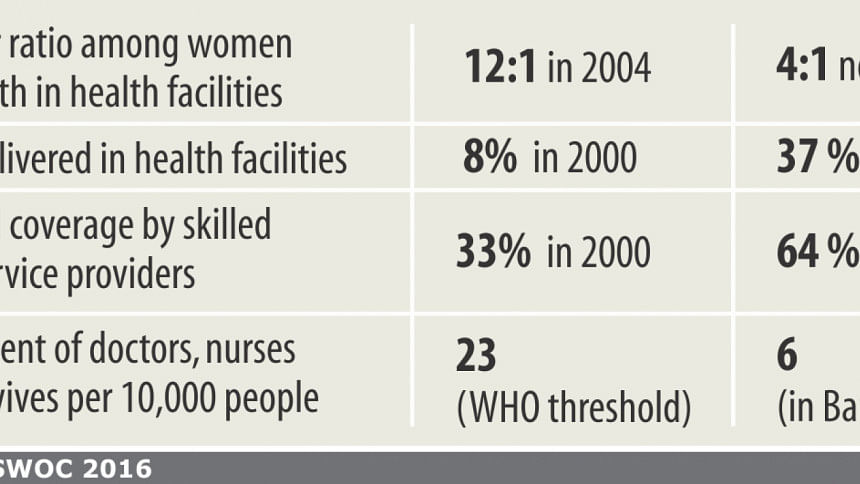More poor women giving birth in health facilities

Bangladesh has substantially bridged the rich-poor gap in terms of women giving birth in health facilities.
However, the country has far less number of physicians, nurses and midwives than the minimum required number.
In its annual flagship report, the United Nations Children's Fund (Unicef) notes that Bangladesh has been making progress towards equity in terms of deliveries that take place in health facilities.
The ratio of poorest-to-richest women delivering in a health facility was 1 to 12 in 2004. But the disparity has now dropped to 1 to 4, according to The State of the World's Children (SWOC) report 2016, released globally yesterday.
The SWOC report says the proportion of babies delivered in health facilities increased from 8 percent to 37 percent between 2000 and 2014. And antenatal coverage (pregnancy period) by skilled health service providers also rose from 33 percent to 64 percent.
It, however, notes, "Nevertheless, large disparities remain. The wealth gap in access to skilled antenatal care declined only marginally, coverage is 36 percent for the poorest women and 90 percent for the wealthiest."
Unicef also sheds light on regional disparity, saying Sylhet and Barisal divisions are lagging behind in terms of getting benefits of skilled birth attendance.
According to the SWOC report, Bangladesh doesn't have enough health providers.
Bangladesh has now got only six doctors, nurses and midwives per 10,000 people against the minimum threshold of 23 prescribed by the World Health Organization, it says.
Out of the 195 countries under the purview of this year's SWOC analysis, 32 have lesser number of doctors, nurses and midwives than the threshold.
Unicef notes that Bangladesh has made solid progress in recent years in reducing under-five mortality rate (U5MR) and partially attributed the reduction to the expansion of community-based health interventions.
"Accelerated progress will depend on expanded and more equitable provision of antenatal care and skilled birth attendance," says the report.
In Bangladesh, U5MR was as high as 144 in 1990, which has come down to 38 now. Still, more than two-thirds of the 195 countries have better U5MR than that of Bangladesh.
U5MR is the probability of dying between birth and exactly five years of age, expressed per 1,000 live births.
With the theme “A fair chance for every child”, this year's SWOC report paints a stark picture of what is in store for the world's poorest children if governments, donors, businesses and international organisations don't accelerate efforts to address their needs.
Based on current trends, 69 million children under five will die from mostly preventable causes, 167 million children will live in poverty, and 750 million women will have been married as children by 2030, the target date for the Sustainable Development Goals, unless the world focuses more on the plight of its most disadvantaged children, says the report.
Unicef Executive Director Anthony Lake said, “Denying hundreds of millions of children a fair chance in life does more than threaten their futures -- by fuelling intergenerational cycles of disadvantage, it imperils the future of their societies.
“We have a choice: Invest in these children now or allow our world to become still more unequal and divided,” added Lake.
The report notes that significant progress has been made in saving children's lives, getting them into school and lifting people out of poverty.
Global under-five mortality rates have more than halved since 1990, boys and girls attend primary school in equal numbers in 129 countries, and the number of people living in extreme poverty worldwide is almost half of what it was in the 1990s.
But this progress has been neither even nor fair, says the report. The poorest children are twice as likely to die before their fifth birthday and to be chronically malnourished than the richest.
Across much of South Asia and sub-Saharan Africa, children born to mothers with no education are almost three times more likely to die before they are five, compared to those born to mothers with a secondary education. And girls from the poorest households are twice as likely to be married as children than girls from the wealthiest households.
Nowhere is the outlook grimmer than in sub-Saharan Africa where at least 247 million children -- or two in three -- live in multidimensional poverty, deprived of what they need to survive and develop.
Nearly 60 percent of 20 to 24-year-olds from the poorest fifth of the population there have been through fewer than four years of schooling.
At current trends, by 2030, sub-Saharan Africa will account for nearly half of the 69 million children who will die before their fifth birthday from mostly preventable causes. And nine out of 10 of the world's children surviving on less than $1.90 a day will live there by that time, projects the report.
Though education plays a unique role in levelling the playing field for children, the number of children who don't attend school has increased since 2011, and a significant proportion of those who go to school are not learning.
About 124 million children today don't go to primary and lower-secondary school, and almost two in five who finish primary school have not learned how to read, write or do simple arithmetic.
“On average, each additional year of education a child receives increases her or his adult earnings by about 10 percent. And for each additional year of schooling completed, on average, by young adults in a country, that country's poverty rate falls by 9 percent,” says the report.
It argues that inequity is neither inevitable, nor insurmountable.
Better data on the most vulnerable children, integrated solutions to the challenges children face, innovative ways to address old problems, more equitable investment and increased involvement by communities -- all these measures can help level the playing field for children.

 For all latest news, follow The Daily Star's Google News channel.
For all latest news, follow The Daily Star's Google News channel. 



Comments